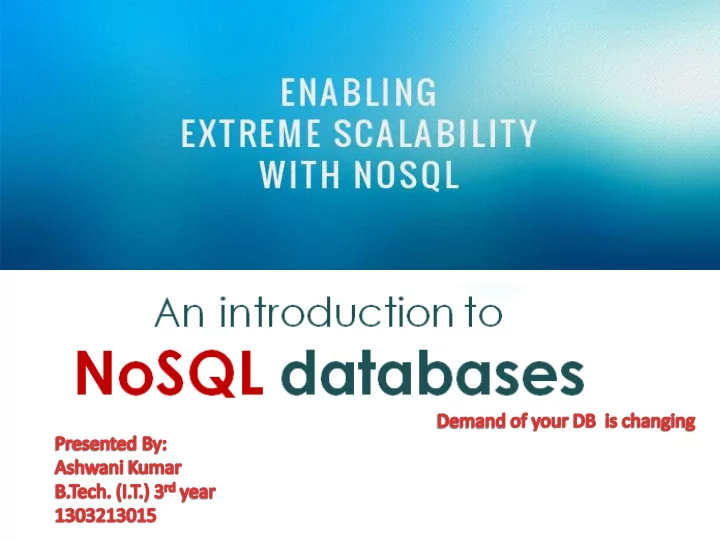

1
2 What is covered in this presentation? A brief history of databases NoSQL WHY, WHAT & WHEN? Characteristics of NoSQL databases Aggregate data models CAP theorem Ashwani Kumar 16 February 2018 NOSQL Databases
3 Introduction Database - Organized collection of data DBMS - Database Management System: a software package with computer programs that controls the creation, maintenance and use of a database Databases are created to operate large quantities of information by inputting, storing, retrieving, and managing that information. Ashwani Kumar 16 February 2018 NOSQL Databases
4 A brief history Ashwani Kumar 16 February 2018 NOSQL Databases
5 Relational databases • Benefits of Relational databases: Designed for all purposes ACID Strong consistancy, concurrency, recovery Mathematical background Standard Query language (SQL) Lots of tools to use with i.e: Reporting services, entity frameworks, ... Ashwani Kumar 16 February 2018 NOSQL Databases
6 SQL databases Ashwani Kumar 16 February 2018 NOSQL Databases
7 RDBMS Ashwani Kumar 16 February 2018 NOSQL Databases
8 NoSQL why, what and when? But... Relational databases were not built for distributed applications. Because... Joins are expensive Hard to scale horizontally Impedance mismatch occurs Expensive (product cost, hardware, Maintenance) Ashwani Kumar 16 February 2018 NOSQL Databases
9 NoSQL why, what and when? And.... It’s weak in: Speed (performance) High availability Partition tolerance Ashwani Kumar 16 February 2018 NOSQL Databases
Why NOSQL now?? Ans. Driving Trends 11 Ashwani Kumar 16 February 2018 NOSQL Databases
Side note: RDBMS performance 12 Ashwani Kumar 16 February 2018 NOSQL Databases
13 But.. What’s NoSQL? But.. What’s NoSQL? A No SQL database provides a mechanism for storage and retrieval of data that employs less constrained consistency models than traditional relational database No SQL systems are also referred to as "NotonlySQL“ to emphasize that they do in fact allow SQL-like query languages to be used. Ashwani Kumar 16 February 2018 NOSQL Databases
Characteristics of NoSQL databases 14 NoSQL avoids: Overhead of ACID transactions Complexity of SQL query Burden of up-front schema design DBA presence Transactions (It should be handled at application layer) Provides: Easy and frequent changes to DB Fast development Large data volumes(eg.Google) Schema less Ashwani Kumar 16 February 2018 NOSQL Databases
NoSQL why, what and when? 10 Ashwani Kumar 16 February 2018 NOSQL Databases
NoSQL is getting more & more popular 15 Ashwani Kumar 16 February 2018 NOSQL Databases
What is a schema-less datamodel? 16 In relational Databases: You can’t add a record which does not fit the schema You need to add NULLs to unused items in a row We should consider the datatypes. i.e : you can’t add a stirng to an interger field You can’t add multiple items in a field (You should create another table: primary-key, foreign key, joins, normalization, ... !!!) Ashwani Kumar 16 February 2018 NOSQL Databases
What is a schema-less datamodel? 17 In NoSQL Databases: There is no schema to consider There is no unused cell There is no datatype (implicit) Most of considerations are done in application layer We gather all items in an aggregate (document) Ashwani Kumar 16 February 2018 NOSQL Databases
Aggregate Data Models 18 NoSQL databases are classified in four major datamodels: • Key-value • Document • Column family • Graph Each DB has its own query language Ashwani Kumar 16 February 2018 NOSQL Databases
Key-value data model 19 Simplest NOSQL databases The main idea is the use of a hash table Access data (values) by strings called keys Data has no required format data may have any format Data model: (key, value) pairs Basic Operations: Insert(key,value), Fetch(key), Update(key), Delete(key) Ashwani Kumar 16 February 2018 NOSQL Databases
Column family data model 20 The column is lowest/smallest instance of data. It is a tuple that contains a name, a value and a timestamp Ashwani Kumar 16 February 2018 NOSQL Databases
Column family data model 21 Some statistics about Facebook Search (using Cassandra ) MySQL > 50 GB Data Writes Average : ~300 ms Reads Average : ~350 ms Rewritten with Cassandra > 50 GB Data Writes Average : 0.12 ms Reads Average : 15 ms Ashwani Kumar 16 February 2018 NOSQL Databases
Graph data model 22 Based on Graph Theory. Scale vertically, no clustering. You can use graph algorithms easily Transactions ACID Ashwani Kumar 16 February 2018 NOSQL Databases
Document based data model 23 • Pair each key with complex data structure known as data structure. • Indexes are done via B-Trees. • Documents can contain many different key-value pairs, or key-array pairs, or even nested documents. Ashwani Kumar 16 February 2018 NOSQL Databases
Document based data model 24 Ashwani Kumar 16 February 2018 NOSQL Databases
SQL vs NOSQL 25 Ashwani Kumar 16 February 2018 NOSQL Databases
What we need ? 26 • We need a distributed database system having such features: • – Fault tolerance • – High availability • – Consistency • – Scalability Which is impossible!!! According to CAP theorem Ashwani Kumar 16 February 2018 NOSQL Databases
CAP theorem 27 We can not achieve all the three items In distributed database systems (center) Ashwani Kumar 16 February 2018 NOSQL Databases
CAP theorem 28 Ashwani Kumar 16 February 2018 NOSQL Databases
Conclusion…. 29 Ashwani Kumar 16 February 2018 NOSQL Databases
References.. 30 nosql -database.org/ https://www.mongodb.com/ nosql -explained www.couchbase.com/ nosql -resources/what-is- no - sql http://nosql-database.org/ "NoSQL DEFINITION: Next Generation Databases mostly addressing some of the points: being non-relational, distributed, open- source and horizontally scalable“ NoSQL distilled, Martin Fowler Please like and follow at www.slideshare.net/AshwaniKumar274 Ashwani Kumar 16 February 2018 NOSQL Databases
31 Ashwani Kumar 16 February 2018 NOSQL Databases
Recommend
More recommend